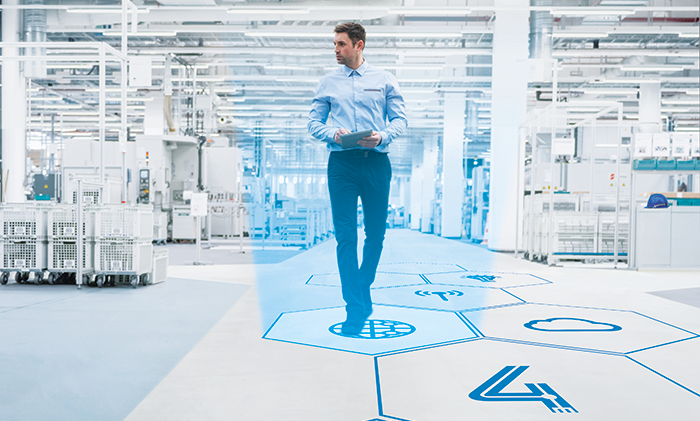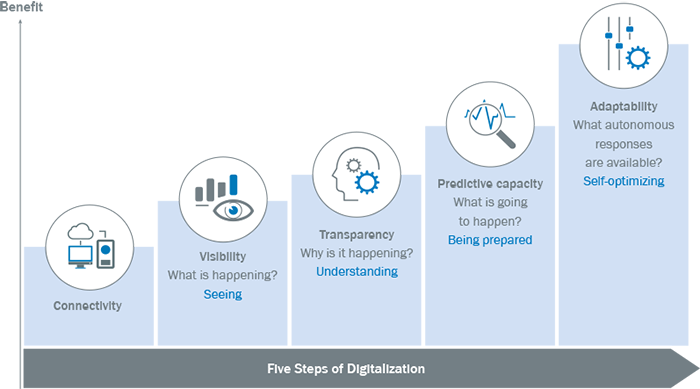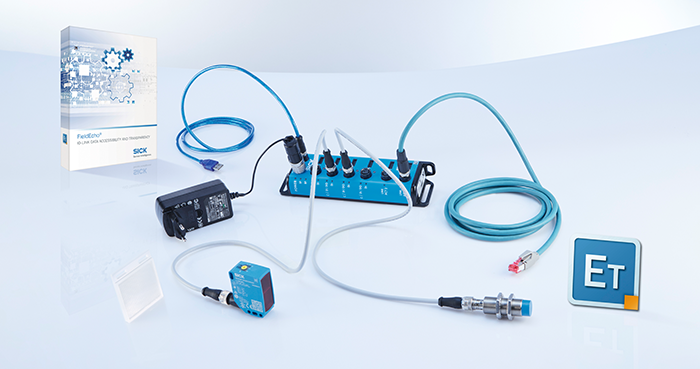When people talk about Industry 4.0, many immediately think of the cloud. However, that is just the tip of the iceberg. Digitalization begins in the field, with the individual sensor, the cloud comes later. Connectivity is required in the field. The best thing: this “connectivity” is often already there anyway - hardly anyone knows about it. This means that some existing machines become significantly more intelligent with very little effort. At Sick there is the first quantum leap in the direction of digitalization for less than 300 euros - for old and new systems.
5 steps to digitalization and why you can forget the cloud for now
Everyone is talking about the cloud. The “big cloud” is increasingly becoming the virtual center of Industry 4.0. This is often accompanied by discomfort. After all, who wants their valuable data to go around on the Internet? At least when it comes to manufacturing - some people are a little less reserved in private. The concerns are understandable as well as justified. Because - the reports in the media show us repeatedly - "Big Brother" is looking over our shoulders. Or rather, at the company and its best-kept secrets.
From the bottom up
Americans, Chinese, Russians and the rest of the world - the big "spying" has long started. Everywhere and constantly, data is illegally tapped, - by whoever. It is understandable that, from the point of view of many company executives, this is a real obstacle and one should rather exercise caution first. However, too much is often thrown into one pot. Because digitalization does not necessarily mean cloud. And above all, not every cloud is the beginning of the end. In any case, the starting signal for Industry 4.0 should come from a technical point of view at the very other end - at the field level, close to the components of the machine. Because there is great potential dormant that can be quickly leveraged in the first step - even without spending a lot of money.
5 central questions
"How do you get data with added value? What is happening? Why does it happen? What will happen? And how can automated measures or reactions take place? These questions form the guideline for the five milestones on digitalization,” says Rene Pfaller. The Head of Product Management at Sick Austria explains: “The answers lead to digitalization in five steps - but you should definitely pay attention to the correct order. Because it applies: Without sensors and connectivity, there is no data - without data there is no visualization and transparency - and without digitalization, there is no Industry 4.0. Therefore, thinking about future manufacturing should not start with the cloud, but at the other end, with sensors in the field. ”
5 steps into the future
Data with added value is obtained through “connectivity”, networkable components. The focus is particularly on sensors, because they are the number 1 provider of information. "Visualization / visibility" is the second step and answers the question of what happens on site. Only then can you focus on the topic of "transparency or understanding". This clarifies why something happens. Once you understand that, you can look into the future and use “forecasting ability” to predict what will happen in the future. This is the basis for the fifth step - the automated implementation of reactions or measures, in other words the "adaptability and self-optimization".
Evolution of digitalization
None of these five steps or technical expansion stages can be skipped. The development follows a clear evolution - in practice and in theory. Only when the lower levels have been reached, can the next level be climbed. Rene Pfaller: “Connectivity is the solid basis for all further stages. If 'Industry 3.9' is directly on the component, i.e. solved on the last meter, then it continues. That is why it is getting exciting on the way to digitalization below the fieldbus system, thanks to IO-Link. "
Sensors - the suppliers of the data
What is needed, are intelligent sensors that are able to communicate bidirectionally beyond the usual I / O signal. This is usually not a problem with more complex sensors with digital interfaces. But what about classic I / Os and analog sensors? This is where IO-Link and the smart sensors from Sick come into play. Retrofitting is the order of the day because smart sensors open up interesting opportunities and create added value. They record real operating states, convert them into digital data and make them available to the process control.
Sick focuses on four decisive dimensions. Enhanced sensing means the best sensor performance for stable processes. In addition, there is highly efficient communication for more flexibility and transparency down to the lowest field level. These are the “basics” for every smart sensor from Sick. In addition, some “Smart Sensors” offer diagnostic and / or Smart Task functionalities for customized information directly from the sensor.
IO-Link - often already there but not in use
Anyone who believes that he has to dig deep into his pockets for IO-Link is wrong. Because IO-Link is often already there - without you knowing it. Rene Pfaller: “The majority of our standard sensors have been equipped with IO-Link for many years. It just is not used on older machines. Not much is missing from the digital quantum leap. You only need an IO-Link master (Sensor Integration Gateway SIG 200) or an IO-Link device (SIG100) and you have already opened the door to Industry 4.0 functions and decentralized intelligence outside of the controller. Here we are talking about really low costs. It starts at less than 300 euros. "
A huge leap for little money
For beginners into the digital world, Sick offers a practical 'Starter Kit' for € 290 net. The set includes the IO-Link master SIG200, an inductive and an optical IO-Link sensor (IMC and WLG16) including reflector. All the necessary connection cables and a power supply are already included in the set. There is also a free trial version of the FieldEcho software for up to 4 ports. This enables parameterization and monitoring of all IO-Link devices in a system. Rene Pfaller: "This 'package' is unbeatable. It enables the perfect start for everyone, who has not yet dealt with IO-Link. It goes straight into practice. "
Advanced Connectivity
Want more connectivity? No problem, for example, via the REST API - an interface for Representational State Transfer - in the SIG200. It is based on the standards of the "www" and enables reliable network communication between servers and clients. The ideal basis for networked applications in the industry and a practical way to retrieve information from an "intelligent" field device. For example, you can display them in a visualization, configure sensors and connect them to ERP, MES or other cloud-based systems.
Is someone there?
Another practical tool is FieldEcho from Sick. Regardless of the SPS used, the fieldbus and the IO-Link master, automatically recognizes all IO-Link participants from all manufacturers in one machine and also downloads the appropriate device descriptions (IODD). But this is far from it. With FieldEcho, IO-Link participants can be parameterized and monitored over their entire life cycle, regardless of the control system or fieldbus. The IO-Link device data is read, written and made available to the FieldEcho front end. Thanks to the REST API, the data is also accessible to third-party applications. Of course, FieldEcho also works on-premises, meaning in your own network without an internet connection.
Visualize - see what is going on
What happens on my machine? This is a question, which has not always been clear to answer. In stage two, digitalization provides real bright spots because it offers information that was previously not available. With the right visualization, everything becomes clear and understandable. FieldEcho Dashboard scores with a modern, web-based graphical user interface, which can either be displayed via a browser or integrated into the HMI of a machine itself. It visualizes all configured IO-Link masters and connected IO-Link sensors or actuators and offers a detailed insight into the data - including alarm functions.
Plug-and-play Condition Monitoring
The monitoring box also offers the best visualization. It enables simple plug-and-play condition monitoring and analysis of data without the need for programming knowledge. Data history and documentation as well as alarm functions are of course also on board. In this way, you can reduce unplanned machine failures, reduce downtimes and thus increase machine availability.
Transparency - why does something happen?
It goes even further in stage three. Many insights become a perspective. Well thought-out software solutions ensure transparency and thus enable understanding of the interrelations. Sick scores again with FieldEcho and the Monitoring Box. Conclusions can be drawn from data records or events. For example, due to changes in signals from a sensor, a need for maintenance can be recognized, such as an urgent cleaning of a sensor.
Predictability - what will happen?
Sick looks into the future with its advanced analytics solutions in stage four. Application-oriented software packages make it possible to predict what will happen. For example, the future failure of a component or the planning of a service interval so that it does not get that far. Illustrative examples of this can be found in parcel logistics or in the luggage area at airports. Here, “Baggage Analytics” ensures, among other things, reliable validation of the integrity of luggage at important operating points or faster localization of misdirected luggage. Parcel handling is also about logistics monitoring and the associated diagnostics. “Analytics” thus ensures higher system performance, an acceleration of decision-making processes and improved supplier compliance thanks to simple image and data exchange.
Adaptability - machines optimize machines
The final stage five focuses on automated reactions and measures. This calls for correspondingly innovative software solutions, such as artificial intelligence (AI), which continuously monitors and optimizes a machine. Overall, this is still a long way off, but selected examples and applications are already available today. For example, Sick relies on deep learning in image processing. Deviations from a learned image or process can be recognized without these errors having to be defined or characterized beforehand. This saves time-consuming programming and opens up completely new possibilities. The utopia of lot size 1 on a completely self-adapting machine would also be located in this expansion stage.
Analog goes digital
In summary, the trend is clear: yesterday was analog - the future is digital. This is how IO-Link shows its strengths. However, this does not go from 0 to 100 in a snap. Digitalization is an evolutionary process that takes time and starts with small steps. That is why the cloud is not the central issue at the beginning.
The expert's tip: You should work from the bottom up, i.e. start with the machine's sensors. The hurdles are smaller than you think and even existing systems often have more “connectivity” on board than you can see at first glance. Even the use of less than 300 euros can catapult selected areas of a machine into the digital age and thus contribute significantly to the efficiency of a system. Sick supports its customers with special starter kits, training courses, practical examples and accompanies them in pilot applications - this is how it goes step by step into the future 4.0.
The article was published in the magazin Austromatisierung, Edition 2/2020.
Rene Pfaller
Head of Product Management
Rene Pfaller has been with SICK since 2011. He is responsible for the product management at SICK Austria and together with his team, he has various responsibilities from developing to introducing new products, systems and services for our customers. Additionally he is an expert in Industry 4.0 and IIoT topics.
Do you have any questions or would you like a personal consultation?




